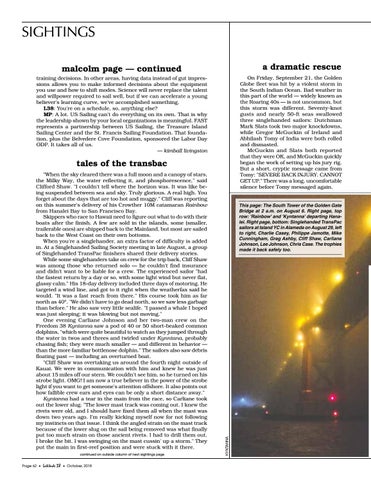SIGHTINGS a dramatic rescue
malcolm page — continued
On Friday, September 21, the Golden Globe fleet was hit by a violent storm in the South Indian Ocean. Bad weather in this part of the world — widely known as the Roaring 40s — is not uncommon, but this storm was different. Seventy-knot gusts and nearly 50-ft seas swallowed three singlehanded sailors: Dutchman Mark Slats took two major knockdowns, while Gregor McGuckin of Ireland and Abhilash Tomy of India were both rolled and dismasted. McGuckin and Slats both reported that they were OK, and McGuckin quickly began the work of setting up his jury rig. But a short, cryptic message came from Tomy: "SEVERE BACK INJURY. CANNOT GET UP." There was a long, uncomfortable silence before Tomy messaged again.
training decisions. In other areas, having data instead of gut impressions allows you to make informed decisions about the equipment you use and how to shift modes. Science will never replace the talent and willpower required to sail well, but if we can accelerate a young believer's learning curve, we've accomplished something. L38: You're on a schedule, so, anything else? MP: A lot. US Sailing can't do everything on its own. That is why the leadership shown by your local organizations is meaningful. FAST represents a partnership between US Sailing, the Treasure Island Sailing Center and the St. Francis Sailing Foundation. That foundation, plus the Belvedere Cove Foundation, sponsored the Labor Day ODP. It takes all of us. — kimball livingston
tales of the transbac
continued on outside column of next sightings page Page 62 •
Latitude 38
• October, 2018
This page: The South Tower of the Golden Gate Bridge at 2 a.m. on August 6. Right page, top row: 'Rainbow' and 'Kyntanna' departing Hanalei. Right page, bottom: Singlehanded TransPac sailors at Island YC in Alameda on August 29, left to right, Charlie Casey, Philippe Jamotte, Mike Cunningham, Greg Ashby, Cliff Shaw, Carliane Johnson, Lee Johnson, Chris Case. The trophies made it back safely too.
KYNTANNA
"When the sky cleared there was a full moon and a canopy of stars, the Milky Way, the water reflecting it, and phosphorescence," said Clifford Shaw. "I couldn't tell where the horizon was. It was like being suspended between sea and sky. Truly glorious. A real high. You forget about the days that are too hot and muggy." Cliff was reporting on this summer's delivery of his Crowther 10M catamaran Rainbow from Hanalei Bay to San Francisco Bay. Skippers who race to Hawaii need to figure out what to do with their boats after the finish. A few are sold in the islands, some (smaller, trailerable ones) are shipped back to the Mainland, but most are sailed back to the West Coast on their own bottoms. When you're a singlehander, an extra factor of difficulty is added in. At a Singlehanded Sailing Society meeting in late August, a group of Singlehanded TransPac finishers shared their delivery stories. While some singlehanders take on crew for the trip back, Cliff Shaw was among those who returned solo — he couldn't find insurance and didn't want to be liable for a crew. The experienced sailor "had the fastest return by a day or so, with some light wind but never flat, glassy calm." His 18-day delivery included three days of motoring. He targeted a wind line, and got to it right when the weatherfax said he would. "It was a fast reach from there." His course took him as far north as 40°. "We didn't have to go dead north, so we saw less garbage than before." He also saw very little sealife. "I passed a whale I hoped was just sleeping; it was blowing but not moving." One evening Carliane Johnson and her two-man crew on the Freedom 38 Kyntanna saw a pod of 40 or 50 short-beaked common dolphins, "which were quite beautiful to watch as they jumped through the water in twos and threes and twirled under Kynntana, probably chasing fish; they were much smaller — and different in behavior — than the more familiar bottlenose dolphin." The sailors also saw debris floating past — including an overturned boat. "Cliff Shaw was overtaking us around the fourth night outside of Kauai. We were in communication with him and knew he was just about 15 miles off our stern. We couldn't see him, so he turned on his strobe light. OMG! I am now a true believer in the power of the strobe light if you want to get someone's attention offshore. It also points out how fallible crew ears and eyes can be only a short distance away." Kyntanna had a tear in the main from the race, so Carliane took out the lower slug. "The lower mast track was coming out. I knew the rivets were old, and I should have fixed them all when the mast was down two years ago. I'm really kicking myself now for not following my instincts on that issue. I think the angled strain on the mast track because of the lower slug on the sail being removed was what finally put too much strain on those ancient rivets. I had to drill them out. I broke the bit. I was swinging on the mast cussin' up a storm." They put the main in first-reef position and were stuck with it there.
